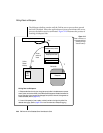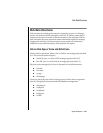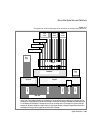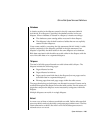
2-78 IBM Informix OnLine Database Server Administrator’s Guide
Writing Data to a Blobspace
In addition, since database server processes must wait for the checkpoint to
complete, the page-cleaner daemons are not competing with a large number
of processes for CPU time. As a result, the page cleaners can finish their work
with less context switching.
Big-Buffer Write
Each OnLine big buffer is the size of eight regular buffers, or eight times
BUFFSIZE. Whenever multiple pages to be written to disk are physically
contiguous, OnLine uses a big buffer to write up to eight pages in a single
I/O
operation. Refer to page 2-55 for more details about the big buffers.
Writing Data to a Blobspace
Blob data (BYTE and TEXT data types) is written to blobspace pages according
to a procedure that differs greatly from the single-page I/O that is performed
when the shared-memory buffer pool is flushed. (Blob data that is stored in a
dbspace is written to disk pages in the same way as any other data type is
written. Refer also to page 2-148 for more information about the structure of
a blobspace blobpage and to page 2-145 for more information about the
structure of a dbspace blob page.)
OnLine provides blobspace blobpages to store large BYTE and TEXT data
types. OnLine does not create or access blobpages by way of the shared-
memory buffer pool. Blobspace blobpages are not written to either the logical
or physical logs.
The reason that blobspace data is not written to shared memory or to the
OnLine logs is that the data is potentially voluminous. If blobspace data
passed through the shared-memory pool, it would dilute the effectiveness of
the pool by driving out index and data pages. In addition, the many kilobytes
of data per blobspace blob would overwhelm the space allocated for the
logical log files and the physical log.
Instead, blobpage data is written directly to disk when it is created.
Blobpages stored on magnetic media are written to archive and logical log
tapes, but not in the same method as dbspace pages. (Refer to page 4-22 for
further information about blobspace logging.)


















